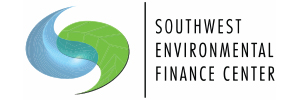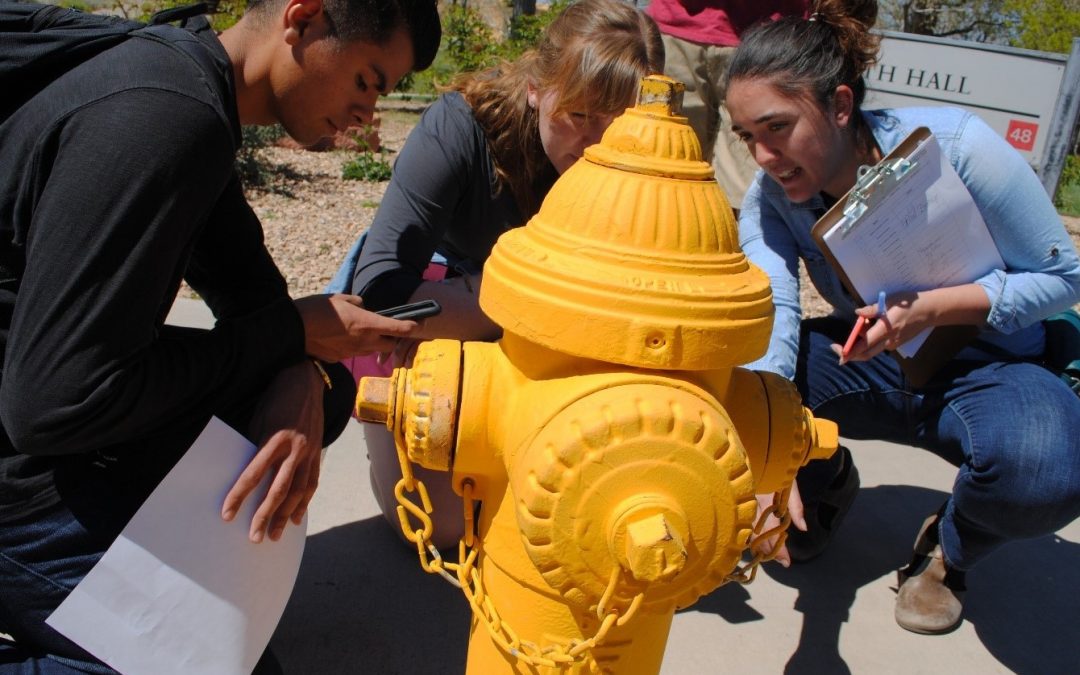*Written by Teresa Gomez.
This past spring the SWEFC organized a pilot initiative designed to encourage undergraduate students at the University of New Mexico to explore careers in the water industry. The collaborative initiative with STEM University led to the six week long Water Utility Mapping Academy. Over the course of the Academy, Teresa Gomez, James Markham and Mark Ogrentz introduced students to water system components and taught them the basics of GIS data collection and mapping. The EFC’s goal was to sufficiently prepare students so that they could create water utility maps for small water systems around New Mexico over the course of the summer.
Below is a summary of the curriculum and activities our students completed over the course of the Academy.
Week 1:
After introducing them to the fundamentals of the water industry, Teresa took the students on a field trip around campus and taught them about various water system assets. Together they learned to identify valves, meters and hydrants as well as the purpose and function of each asset. Students also learned to estimate pipe locations with relation to the location of each of the above-mentioned assets. The skill-building homework assignment in anticipation of the next session was to draw a map of the valves, meters and hydrants in their own neighborhoods.

Image 1: Introduction to the water industry
Week 2:
Mark and James started the second session by going over the homework assignment and asking the students about their experiences. One student stated “ I had never noticed manholes before but now when I walk down the street I notice all the different kinds of manholes that are in the street and I wonder what is inside of them.” Next, Mark and James discussed asset inventories and the information needed to create an appropriate asset inventory before teaching students how to create mapping surveys using Fulcrum, a data collection application.

Image 2: Creating an asset inventory
Week 3:
Students walked around campus and used their phones and Fulcrum to collect GPS locations for UNM hydrants. They also used these applications to collect useful information about the hydrants such as hydrant manufacturer, design pressure, and hydrant condition. Thankfully, UNM Physical Plant staff agreed to provide students with a list of hydrants and their corresponding Asset IDs, estimated locations, and flow rates. This week, the homework assignment was to combine the office data they received from physical plant and the field data they collected on their own.

Image 3: Teresa shows students how to identify and collect hydrant information to input into Fulcrum, the mobile mapping app.

Image 4: Students identify and collect hydrant information to input into Fulcrum, the mobile mapping application.
Weeks 4 & 5:
Over the course of these two weeks, James and Mark introduced the students to ArcGIS. By the end of the fifth session, students created their own maps using the hydrant data they had collected in the field over the course of Week 3.

Image 5: Map of UNM hydrants
Week 6:
Teresa wrapped up the 6 week workshop series with a discussion about the various ways in which maps can be used in the water industry and possible water careers. One student stated “I did not realize the variety of career options available in the water industry! I am going to go home and see what kinds of jobs are available around Albuquerque.” Another student was curious about water industry careers in developing countries, while a third said that he was going to research which classes he would need to take to become a civil engineer.
Following the completion of the Mapping Academy, the SWEFC hired several students as interns to help communities around the state collect asset data and create GIS maps. With the help of our interns, eight communities completed asset maps We are very pleased with the outcome of this pilot project and hope that our interns’ careers will be shaped by the professional experience they accumulated while working with us over the course of the summer. Stay tuned for a blog post by one of our interns!


Recent Comments